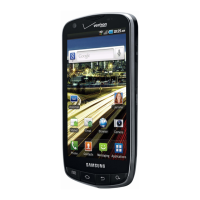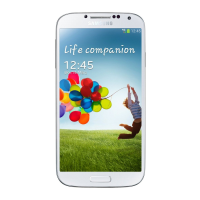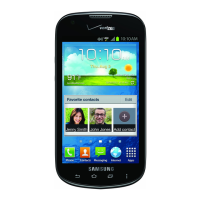Do you have a question about the Samsung SCH-I535 and is the answer not in the manual?
Details on software components under open source licenses.
States product is sold "as is" and disclaims warranties.
Provides the company's headquarters address.
Lists customer care contact details.
Provides the company's website address.
Explains manual structure, navigation, and simulated images.
Instructions for installing SIM, battery, and memory card.
Steps to power the device on and off.
Importance of Google account for Android features.
Benefits of a Samsung account for apps.
How to find the phone number on the device.
How unanswered calls are sent to voicemail.
Information on using the phone with videos and tips.
How the phone acquires service in other networks when traveling.
How to connect a TTY device to the phone.
Lists key hardware and software features of the phone.
Details components on the front of the phone.
Identifies keys and ports on the side of the phone.
Identifies components on the back of the phone.
Explains the main interface and its elements.
Describes how to navigate using keys and touch screen.
How to view and manage alerts and status icons.
Explains the function of the LED status light.
Describes icons and information in the status bar.
Shortcuts to common apps at the bottom of the display.
Apps that run on the Home screen for quick access.
Shortcuts to apps on the Home screen.
How to organize items on the Home screen using folders.
How to change the background image.
Accessing and launching installed applications.
How to input text using the virtual keyboard.
How to synchronize information from various accounts.
Storing and managing contact information.
Assigning shortcuts for quick dialing.
Various methods to initiate phone calls.
Setting up calls between multiple callers.
How to accept or reject incoming calls.
Rejecting calls to send them to voicemail.
Overview of supported message types (Text, MMS, Email, etc.).
Sending and receiving text and multimedia messages.
Receiving emergency broadcasts.
Sending and receiving emails.
Using the Gmail service for email.
Managing voicemail messages.
Chatting with other Google Talk users.
Overview of installed and downloaded apps.
How to get new apps from stores.
Removing downloaded applications.
Changing the view of app icons.
Setting up and managing Wi-Fi connections.
Enabling or disabling Wi-Fi service.
Finding and joining Wi-Fi networks.
Manually configuring new Wi-Fi network details.
Connecting devices directly via Wi-Fi.
Enabling or disabling Wi-Fi Direct.
Pairing and connecting with other Wi-Fi Direct devices.
Sharing phone's internet connection via Wi-Fi.
Activating or deactivating mobile hotspot.
Setting up hotspot name, password, and visibility.
Controlling which devices connect to the hotspot.
Short-range wireless communication technology.
Managing Bluetooth preferences and visibility.
Enabling or disabling Bluetooth.
Searching for and pairing with Bluetooth devices.
Configuring Virtual Private Network connections.
Setting up a new VPN connection.
Sharing phone's internet connection via USB or Bluetooth.
Sharing connection via USB cable.
Sharing connection via Bluetooth.
Sharing information by touching devices together.
Sending content via NFC by holding devices close.
Faster sharing via NFC and Wi-Fi Direct.
Connecting devices directly via Wi-Fi.
Setting up Wi-Fi Direct connections.
Sharing files using DLNA standards.
Managing how content is shared.
Setting network selection and data services.
How to open the main Settings menu.
Managing phone's Wi-Fi connections.
Enabling or disabling Wi-Fi service.
Configuring wireless access points.
Detailed Wi-Fi configuration options.
Sharing phone's internet connection.
Activating or deactivating mobile hotspot.
Setting up hotspot name, password, and visibility.
Managing connected devices for the hotspot.
Short-range wireless communication technology.
Managing Bluetooth connections and visibility.
Controlling mobile data connection and usage.
Enabling or disabling mobile data.
Setting limits and warnings for data usage.
Monitoring data consumption per app.
Additional network configuration options.
Disabling wireless connections.
Managing device content via desktop/browser.
Configuring Virtual Private Network connections.
Setting up a new VPN connection.
Sharing phone's internet connection with other devices.
Sharing connection via USB cable.
Sharing connection via Bluetooth.
Sharing information by touching devices together.
Sending content via NFC by holding devices close.
Faster sharing via NFC and Wi-Fi Direct.
Connecting devices directly via Wi-Fi.
Setting up Wi-Fi Direct connections.
Sharing files using DLNA standards.
Managing how content is shared.
Setting network selection and data services.
Adjusting phone sounds and vibration.
Temporarily silencing sounds except media/alarms.
Setting system volume levels for calls, media, etc.
Adjusting vibration levels for notifications.
Choosing ringtones for incoming calls.
Selecting vibration patterns.
Setting default sounds for notifications.
Enabling simultaneous sound and vibration.
Sounds played when touching phone keypad keys.
Sounds played when touching screen items.
Sound played when locking/unlocking the screen.
Enabling vibration for screen touches.
Controls haptic vibrations in downloaded apps.
Setting alert tones/vibrations for emergency calls.
Adjusting screen settings.
Setting default screen brightness.
Setting delay before automatic screen timeout.
Feature to prevent screen timeout when viewing.
Automatically changing screen orientation.
Setting duration for Menu/Back Keys light.
Setting the font for screen displays.
Setting the font size for screen displays.
Automatically adjusting screen brightness for battery.
Showing battery charge level in the Status bar.
Calibrating phone's motion sensors.
Customizing Home and Lock screen backgrounds.
Information on RF exposure from wireless phones.
Discusses potential health risks from cell phone radiation.
Summarizes research findings on RF and health.
Explains SAR and FCC exposure limits.
User warnings regarding FCC rules and interference.
Receiving Wireless Emergency Alerts.
Guidelines for safe mobile device use while driving.
Promotes responsible driving and awareness of distractions.
Instructions for proper battery handling and storage.
Precautions against heat and explosion risks.
Warning against fire disposal due to explosion risk.
Precautions for handling damaged or leaking batteries.
Warning about potential damage from dropping.
Do not use damaged charging accessories.
Warning about short-circuiting risks.
Use only approved batteries and chargers.
Risks of using non-approved batteries/chargers.
Samsung's commitment to environmental care and recycling.
Avoid using incompatible batteries/chargers.
Risks of using incompatible accessories.
Safety instructions for the travel charger.
Emphasizes saving charger safety instructions.
Information on display use and warnings.
Using GPS and AGPS for location-based services.
Using AGPS for emergency calls and its limitations.
Using maps and directions, and potential inaccuracies.
How emergency calls work and limitations.
Step-by-step guide to making an emergency call.
Suggestions for maintaining the mobile device.
Warning against drying the device in a microwave.
Avoiding exposure to dust and dirt.
Using appropriate cleaning methods.
Avoiding dropping or shaking the device.
Do not paint the mobile device.
Recommendations for safe audio device usage.
Explains risks of loud sounds and noise-induced hearing loss.
General recommendations for safe audio use.
Earphone volume adjustment advice.
Setting volume in a quiet environment.
Awareness of volume adaptation.
Adjusting headphone volume.
Using noise-cancelling headphones instead of high volume.
Limiting listening time to prevent hearing damage.
Precautions after exposure to loud noise.
Avoiding uncomfortable listening volumes.
Contact information for audiology resources.
FCC requirements for mobile device hearing aid compatibility.
FCC requirements for mobile device hearing aid compatibility.
Testing phone with newer wireless technologies for hearing aids.
Preventing children from accessing the mobile device.
FCC notices and warnings regarding device use.
General safety guidelines for mobile devices.
Details on what the warranty covers and for how long.
SAMSUNG's responsibilities during the warranty period.
Steps to obtain warranty service.
Limitations on SAMSUNG's liability.
Warranty disclaimer for third-party apps.
Limitation of liability for third-party application use.
Legal agreement for software use.
Grant of software license rights.
Reservation of software rights and ownership.
Restrictions on end-user rights for software.
Consent for Samsung to collect and use technical data.
EULA applies to software updates and upgrades.
Conditions for transferring the software license.
Compliance with export restrictions for software.
Conditions for termination of the EULA.
Samsung's non-responsibility for third-party applications.
Warranty disclaimer for third-party apps.
Limitation of Samsung's liability for third-party apps.
Restricted rights for U.S. Government end users.
Governing law for the EULA.
Details on software components under open source licenses.
States product is sold "as is" and disclaims warranties.
Provides the company's headquarters address.
Lists customer care contact details.
Provides the company's website address.
Explains manual structure, navigation, and simulated images.
Instructions for installing SIM, battery, and memory card.
Steps to power the device on and off.
Importance of Google account for Android features.
Benefits of a Samsung account for apps.
How to find the phone number on the device.
How unanswered calls are sent to voicemail.
Information on using the phone with videos and tips.
How the phone acquires service in other networks when traveling.
How to connect a TTY device to the phone.
Lists key hardware and software features of the phone.
Details components on the front of the phone.
Identifies keys and ports on the side of the phone.
Identifies components on the back of the phone.
Explains the main interface and its elements.
Describes how to navigate using keys and touch screen.
How to view and manage alerts and status icons.
Explains the function of the LED status light.
Describes icons and information in the status bar.
Shortcuts to common apps at the bottom of the display.
Apps that run on the Home screen for quick access.
Shortcuts to apps on the Home screen.
How to organize items on the Home screen using folders.
How to change the background image.
Accessing and launching installed applications.
How to input text using the virtual keyboard.
How to synchronize information from various accounts.
Storing and managing contact information.
Assigning shortcuts for quick dialing.
Various methods to initiate phone calls.
Setting up calls between multiple callers.
How to accept or reject incoming calls.
Rejecting calls to send them to voicemail.
Overview of supported message types (Text, MMS, Email, etc.).
Sending and receiving text and multimedia messages.
Receiving emergency broadcasts.
Sending and receiving emails.
Using the Gmail service for email.
Managing voicemail messages.
Chatting with other Google Talk users.
Overview of installed and downloaded apps.
How to get new apps from stores.
Removing downloaded applications.
Changing the view of app icons.
Setting up and managing Wi-Fi connections.
Enabling or disabling Wi-Fi service.
Finding and joining Wi-Fi networks.
Manually configuring new Wi-Fi network details.
Connecting devices directly via Wi-Fi.
Enabling or disabling Wi-Fi Direct.
Pairing and connecting with other Wi-Fi Direct devices.
Sharing phone's internet connection via Wi-Fi.
Activating or deactivating mobile hotspot.
Setting up hotspot name, password, and visibility.
Controlling which devices connect to the hotspot.
Short-range wireless communication technology.
Managing Bluetooth preferences and visibility.
Enabling or disabling Bluetooth.
Searching for and pairing with Bluetooth devices.
Configuring Virtual Private Network connections.
Setting up a new VPN connection.
Sharing phone's internet connection via USB or Bluetooth.
Sharing connection via USB cable.
Sharing connection via Bluetooth.
Sharing information by touching devices together.
Sending content via NFC by holding devices close.
Faster sharing via NFC and Wi-Fi Direct.
Connecting devices directly via Wi-Fi.
Setting up Wi-Fi Direct connections.
Sharing files using DLNA standards.
Managing how content is shared.
Setting network selection and data services.
How to open the main Settings menu.
Managing phone's Wi-Fi connections.
Enabling or disabling Wi-Fi service.
Configuring wireless access points.
Detailed Wi-Fi configuration options.
Sharing phone's internet connection.
Activating or deactivating mobile hotspot.
Setting up hotspot name, password, and visibility.
Managing connected devices for the hotspot.
Short-range wireless communication technology.
Managing Bluetooth connections and visibility.
Controlling mobile data connection and usage.
Enabling or disabling mobile data.
Setting limits and warnings for data usage.
Monitoring data consumption per app.
Additional network configuration options.
Disabling wireless connections.
Managing device content via desktop/browser.
Configuring Virtual Private Network connections.
Setting up a new VPN connection.
Sharing phone's internet connection with other devices.
Sharing connection via USB cable.
Sharing connection via Bluetooth.
Sharing information by touching devices together.
Sending content via NFC by holding devices close.
Faster sharing via NFC and Wi-Fi Direct.
Connecting devices directly via Wi-Fi.
Setting up Wi-Fi Direct connections.
Sharing files using DLNA standards.
Managing how content is shared.
Setting network selection and data services.
Adjusting phone sounds and vibration.
Temporarily silencing sounds except media/alarms.
Setting system volume levels for calls, media, etc.
Adjusting vibration levels for notifications.
Choosing ringtones for incoming calls.
Selecting vibration patterns.
Setting default sounds for notifications.
Enabling simultaneous sound and vibration.
Sounds played when touching phone keypad keys.
Sounds played when touching screen items.
Sound played when locking/unlocking the screen.
Enabling vibration for screen touches.
Controls haptic vibrations in downloaded apps.
Setting alert tones/vibrations for emergency calls.
Adjusting screen settings.
Setting default screen brightness.
Setting delay before automatic screen timeout.
Feature to prevent screen timeout when viewing.
Automatically changing screen orientation.
Setting duration for Menu/Back Keys light.
Setting the font for screen displays.
Setting the font size for screen displays.
Automatically adjusting screen brightness for battery.
Showing battery charge level in the Status bar.
Calibrating phone's motion sensors.
Customizing Home and Lock screen backgrounds.
Information on RF exposure from wireless phones.
Discusses potential health risks from cell phone radiation.
Summarizes research findings on RF and health.
Explains SAR and FCC exposure limits.
User warnings regarding FCC rules and interference.
Receiving Wireless Emergency Alerts.
Guidelines for safe mobile device use while driving.
Promotes responsible driving and awareness of distractions.
Instructions for proper battery handling and storage.
Precautions against heat and explosion risks.
Warning against fire disposal due to explosion risk.
Precautions for handling damaged or leaking batteries.
Warning about potential damage from dropping.
Do not use damaged charging accessories.
Warning about short-circuiting risks.
Use only approved batteries and chargers.
Risks of using non-approved batteries/chargers.
Samsung's commitment to environmental care and recycling.
Avoid using incompatible batteries/chargers.
Risks of using incompatible accessories.
Safety instructions for the travel charger.
Emphasizes saving charger safety instructions.
Information on display use and warnings.
Using GPS and AGPS for location-based services.
Using AGPS for emergency calls and its limitations.
Using maps and directions, and potential inaccuracies.
How emergency calls work and limitations.
Step-by-step guide to making an emergency call.
Suggestions for maintaining the mobile device.
Warning against drying the device in a microwave.
Avoiding exposure to dust and dirt.
Using appropriate cleaning methods.
Avoiding dropping or shaking the device.
Do not paint the mobile device.
Recommendations for safe audio device usage.
Explains risks of loud sounds and noise-induced hearing loss.
General recommendations for safe audio use.
Earphone volume adjustment advice.
Setting volume in a quiet environment.
Awareness of volume adaptation.
Adjusting headphone volume.
Using noise-cancelling headphones instead of high volume.
Limiting listening time to prevent hearing damage.
Precautions after exposure to loud noise.
Avoiding uncomfortable listening volumes.
Contact information for audiology resources.
FCC requirements for mobile device hearing aid compatibility.
FCC requirements for mobile device hearing aid compatibility.
Testing phone with newer wireless technologies for hearing aids.
Preventing children from accessing the mobile device.
FCC notices and warnings regarding device use.
General safety guidelines for mobile devices.
Details on what the warranty covers and for how long.
SAMSUNG's responsibilities during the warranty period.
Steps to obtain warranty service.
Limitations on SAMSUNG's liability.
Warranty disclaimer for third-party apps.
Limitation of liability for third-party application use.
Legal agreement for software use.
Grant of software license rights.
Reservation of software rights and ownership.
Restrictions on end-user rights for software.
Consent for Samsung to collect and use technical data.
EULA applies to software updates and upgrades.
Conditions for transferring the software license.
Compliance with export restrictions for software.
Conditions for termination of the EULA.
Samsung's non-responsibility for third-party applications.
Warranty disclaimer for third-party apps.
Limitation of Samsung's liability for third-party apps.
Restricted rights for U.S. Government end users.
Governing law for the EULA.
| Model | Samsung SCH-I535 |
|---|---|
| Announced | 2012, May |
| Weight | 133 g (4.69 oz) |
| SIM | Micro-SIM |
| Display Type | Super AMOLED capacitive touchscreen, 16M colors |
| Display Protection | Corning Gorilla Glass 2 |
| Chipset | Qualcomm MSM8960 Snapdragon S4 Plus |
| CPU | Dual-core 1.5 GHz Krait |
| GPU | Adreno 225 |
| Internal Storage | 16 GB |
| RAM | 2 GB |
| Main Camera Video | 1080p@30fps |
| Selfie Camera | 1.9 MP |
| Loudspeaker | Yes |
| 3.5mm jack | Yes |
| WLAN | Wi-Fi 802.11 a/b/g/n, dual-band, Wi-Fi Direct, DLNA, hotspot |
| GPS | Yes, with A-GPS, GLONASS |
| NFC | Yes |
| Radio | No |
| Sensors | Accelerometer, gyro, proximity, compass, barometer |
| Colors | Pebble Blue, Marble White |
| Network Technology | LTE |
| Status | Available |
| Display Size | 4.8 inches |
| Display Resolution | 720 x 1280 pixels |
| Operating System | Android 4.0.4 (Ice Cream Sandwich), upgradable to 4.4.2 (KitKat) |
| Card Slot | microSD, up to 64 GB |
| Main Camera | 8 MP |
| Main Camera Features | LED flash |
| Bluetooth | 4.0, A2DP |
| USB | microUSB 2.0 |
| Battery | 2100 mAh |
| Talk time | Up to 3G |











